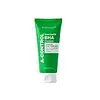What's inside
What's inside
 Key Ingredients
Key Ingredients

 Benefits
Benefits

 Concerns
Concerns

 Ingredients Side-by-side
Ingredients Side-by-side

Houttuynia Cordata Extract
Skin ConditioningGlycerin
HumectantMyristic Acid
CleansingWater
Skin ConditioningLauric Acid
CleansingPalmitic Acid
EmollientStearic Acid
CleansingPotassium Hydroxide
BufferingGlyceryl Stearate
EmollientDecyl Glucoside
CleansingCocamidopropyl Betaine
CleansingSorbitan Olivate
Emulsifying1,2-Hexanediol
Skin ConditioningSalicylic Acid
MaskingDipropylene Glycol
HumectantLauramide DEA
Hydroxyacetophenone
AntioxidantSodium Chloride
MaskingCaprylyl Glycol
EmollientBetaine
HumectantCapric Acid
CleansingSalix Alba Bark Extract
AstringentCladosiphon Okamuranus Extract
Skin ConditioningCentella Asiatica Leaf Extract
Skin ConditioningCamellia Sinensis Leaf Extract
AntimicrobialDisodium EDTA
Arachidic Acid
CleansingCoffea Arabica Seed Extract
MaskingCitrus Aurantium Bergamia Leaf Extract
AstringentPinus Densiflora Leaf Extract
AntimicrobialDipotassium Glycyrrhizate
HumectantHouttuynia Cordata Extract, Glycerin, Myristic Acid, Water, Lauric Acid, Palmitic Acid, Stearic Acid, Potassium Hydroxide, Glyceryl Stearate, Decyl Glucoside, Cocamidopropyl Betaine, Sorbitan Olivate, 1,2-Hexanediol, Salicylic Acid, Dipropylene Glycol, Lauramide DEA, Hydroxyacetophenone, Sodium Chloride, Caprylyl Glycol, Betaine, Capric Acid, Salix Alba Bark Extract, Cladosiphon Okamuranus Extract, Centella Asiatica Leaf Extract, Camellia Sinensis Leaf Extract, Disodium EDTA, Arachidic Acid, Coffea Arabica Seed Extract, Citrus Aurantium Bergamia Leaf Extract, Pinus Densiflora Leaf Extract, Dipotassium Glycyrrhizate
Water
Skin ConditioningGlycerin
HumectantDisodium Cocoamphodiacetate
CleansingCoco-Glucoside
CleansingLauryl Glucoside
CleansingSodium Chloride
MaskingSodium Cocoyl Apple Amino Acids
Skin ConditioningCeramide NP
Skin ConditioningSodium Hyaluronate
HumectantPanthenol
Skin ConditioningOenothera Biennis Oil
EmollientSimmondsia Chinensis Seed Oil
EmollientSclerocarya Birrea Seed Oil
HumectantLimnanthes Alba Seed Oil
Skin ConditioningHelianthus Annuus Seed Oil
EmollientCocos Nucifera Oil
MaskingHydroxypropyltrimonium Hyaluronate
Centella Asiatica Leaf Extract
Skin ConditioningOryza Sativa Bran Water
MaskingNelumbo Nucifera Flower Extract
Skin ConditioningSodium Acetylated Hyaluronate
HumectantHydrolyzed Hyaluronic Acid
HumectantChamomilla Recutita Flower Extract
MaskingHyaluronic Acid
HumectantSodium Hyaluronate Crosspolymer
HumectantHydrolyzed Sodium Hyaluronate
Skin ConditioningAcrylates/C10-30 Alkyl Acrylate Crosspolymer
Emulsion StabilisingHexylene Glycol
EmulsifyingCitric Acid
BufferingChlorphenesin
AntimicrobialEthylhexylglycerin
Skin ConditioningXanthan Gum
EmulsifyingTetrasodium Glutamate Diacetate
Butylene Glycol
Humectant1,2-Hexanediol
Skin ConditioningSaccharide Isomerate
HumectantCaprylic/Capric Triglyceride
MaskingHydrogenated Lecithin
EmulsifyingSodium Citrate
BufferingPotassium Hyaluronate
Skin ConditioningWater, Glycerin, Disodium Cocoamphodiacetate, Coco-Glucoside, Lauryl Glucoside, Sodium Chloride, Sodium Cocoyl Apple Amino Acids, Ceramide NP, Sodium Hyaluronate, Panthenol, Oenothera Biennis Oil, Simmondsia Chinensis Seed Oil, Sclerocarya Birrea Seed Oil, Limnanthes Alba Seed Oil, Helianthus Annuus Seed Oil, Cocos Nucifera Oil, Hydroxypropyltrimonium Hyaluronate, Centella Asiatica Leaf Extract, Oryza Sativa Bran Water, Nelumbo Nucifera Flower Extract, Sodium Acetylated Hyaluronate, Hydrolyzed Hyaluronic Acid, Chamomilla Recutita Flower Extract, Hyaluronic Acid, Sodium Hyaluronate Crosspolymer, Hydrolyzed Sodium Hyaluronate, Acrylates/C10-30 Alkyl Acrylate Crosspolymer, Hexylene Glycol, Citric Acid, Chlorphenesin, Ethylhexylglycerin, Xanthan Gum, Tetrasodium Glutamate Diacetate, Butylene Glycol, 1,2-Hexanediol, Saccharide Isomerate, Caprylic/Capric Triglyceride, Hydrogenated Lecithin, Sodium Citrate, Potassium Hyaluronate
Ingredients Explained
These ingredients are found in both products.
Ingredients higher up in an ingredient list are typically present in a larger amount.
1,2-Hexanediol is a synthetic liquid and another multi-functional powerhouse.
It is a:
- Humectant, drawing moisture into the skin
- Emollient, helping to soften skin
- Solvent, dispersing and stabilizing formulas
- Preservative booster, enhancing the antimicrobial activity of other preservatives
Centella Asiatica Leaf Extract comes from the leaves of an herb plant native to Southeast Asia. Centella Asiatica is rich in antioxidants and amino acids. It can help reduce irritation and soothe the skin.
Many active components found in centella asiatica, such as Madecassic Acid and Asiaticoside, encourage the skin to naturally produce hyaluronic acid. This helps keep our skin hydrated. Many of these components also show antioxidant activity and may help reduce the signs of aging.
Research shows centella asiatica can help increase Type I collagen production by increasing fibroblast production. Fibroblast helps form connective tissue.
The combination of all these properties makes centella asiatica leaf extract effective at soothing the skin.
Other components of centella asiatica leaf extract include Vitamin A, vitamin C, several B vitamins, and Asiatic Acid.
Recent studies found madecassoside may help prevent damage from UV rays by preventing UV-induced inflammation. Further research is needed.
This plant has been used as a medicine and in food for many centuries. As a medicine, it is used to treat burns, scratches, and wounds.
Learn more about Centella Asiatica Leaf ExtractGlycerin is already naturally found in your skin. It helps moisturize and protect your skin.
A study from 2016 found glycerin to be more effective as a humectant than AHAs and hyaluronic acid.
As a humectant, it helps the skin stay hydrated by pulling moisture to your skin. The low molecular weight of glycerin allows it to pull moisture into the deeper layers of your skin.
Hydrated skin improves your skin barrier; Your skin barrier helps protect against irritants and bacteria.
Glycerin has also been found to have antimicrobial and antiviral properties. Due to these properties, glycerin is often used in wound and burn treatments.
In cosmetics, glycerin is usually derived from plants such as soybean or palm. However, it can also be sourced from animals, such as tallow or animal fat.
This ingredient is organic, colorless, odorless, and non-toxic.
Glycerin is the name for this ingredient in American English. British English uses Glycerol/Glycerine.
Learn more about GlycerinChances are, you eat sodium chloride every day. Sodium Chloride is also known as table salt.
This ingredient has many purposes in skincare: thickener, emulsifier, and exfoliator.
You'll most likely find this ingredient in cleansers where it is used to create a gel-like texture. As an emulsifier, it also prevents ingredients from separating.
There is much debate on whether this ingredient is comedogenic. The short answer - comedogenic ratings don't tell the whole story. Learn more about comegodenic ratings here.
The concensus about this ingredient causing acne seems to be divided. Research is needed to understand if this ingredient does cause acne.
Scrubs may use salt as the primary exfoliating ingredient.
Learn more about Sodium ChlorideWater. It's the most common cosmetic ingredient of all. You'll usually see it at the top of ingredient lists, meaning that it makes up the largest part of the product.
So why is it so popular? Water most often acts as a solvent - this means that it helps dissolve other ingredients into the formulation.
You'll also recognize water as that liquid we all need to stay alive. If you see this, drink a glass of water. Stay hydrated!
Learn more about Water